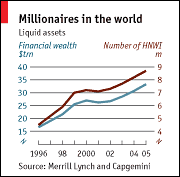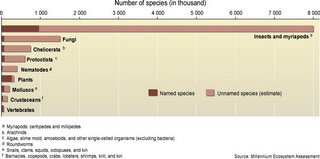The idea behind Al Gore's movie An Inconvenient Truth terrifies me. The idea being you can turn a PowerPoint slide into a 100 minute movie. Seriously? PowerPoint? An entire movie that you have to pay $10 to see? The same PowerPoint slides that have those annoying animations and sounds between slides? The same ones you sit through at work and pray "Dear Jesus, please let this be the last slide"? And they wonder why the box office receipts are going down.
Seriously though, I thought it was a good movie with lots of good information. But, I found it too dire in its predictions, I found Gore to treat the science with too much certainty, and most importantly I was disappointed that there was no plan laid out on how to stop it.
This was a good movie to see if you know nothing about global warming, about what warming has happened over the last 100 years and what might happen in the future due to further warming.
Has it become obligatory for every politician to use 9/11 to back their ideas and plans that have absolutely nothing to do with 9/11? When it came to the rising oceans due to global warming, Gore couldn't help himself and had to point out that the 9/11 memorial in NYC would be underwater if oceans rise by 20 feet. Remember, if you are at all skeptical about anything in this move, the terrorists win.
I was disappointed in was the direness of the predictions. They go beyond consensus science. Gregg Easterbrook states it best here:For instance, this 2005 joint statement by the science academies of the Western nations, including the National Academy of Sciences, warns of sea-level rise of four to 35 inches in the 21st century; this amount of possible sea-level rise is current consensus science.
Yet An Inconvenient Truth asserts that a sea-level rise of 20 feet is a realistic short-term prospect. Gore says the entire Greenland and Antarctic ice sheets could melt rapidly; the film then jumps to animation of Manhattan flooded. Well, all that ice might melt really fast, and a UFO might land in London, too. The most recent major study of ice in the geologic past found that about 130,000 years ago the seas were "several meters above modern levels" and that polar temperatures sufficient to cause a several-meter sea-level rise may eventually result from artificial global warming. The latest major study of austral land ice detected a thawing rate that would add two to three inches to sea level during this century.
If this movie is supposed to be about the science, why scare us to action with tales like that? Even worse, a writeup of the movie had this to say:Drastic climate change, extreme hurricanes, floods, droughts, wildfires, insect plagues, epidemics and other health problems, killer heat waves, the extinction of many plant and animal species, the swamping of our coastal cities as the ice caps in Greenland and Antarctica melt and the oceans rise, rings of social, political and economic chaos rippling out from the centers of environmental disaster.
The timetable: Five to 10 years, before the effects become irreversible.
The movie explained all of the possible outcomes listed here, but they are not nearly as bad as they sound (insect plagues were attacking forests, not crops or people). And the 5-10 year horizon was not mentioned at all. This once again has nothing to do with the consensus science and does nothing but frighten us.
On the website, they state: Deaths from global warming will double in just 25 years -- to 300,000 people a year. Sounds serious until you realize that in 2005 3.1 million people died of AIDS and that 56 million people die a year in the world. The movie is full of scary tales like this that don't talk about their likelihood and don't try and put things in context.
It also points out none of the potentially positive parts of global warming. Warmer weather will mean less demand for heating energy in the winter. Warming might open vast areas of Alaska, Canada and Russia to development. Crop yields in the US and other temperate countries are expected to rise. As I noted before due to the increase in CO2 and warmer temperatures, total life on earth is expected to increase in terms of biomass and net primary productivity. Gregg Easterbrook has another more balanced look at global warming's expected impact here.
With the less dire predictions, global warming is not the #1 issue for government. AIDS still kills more people. Reducing poverty will still have a greater positive impact on peoples lives than fighting global warming. Diseases still need to be fought. One foot ocean rises will cause some problems but they won't be drastic. Species may be lost, but more species may be lost due to deforestation and habitat loss. Global warming is something that needs to be dealt with, but claiming it is the #1 issue, or that we could destroy the planet if we don't deal with it right now is not supported by the science I have read.
Second, I thought he handled the topic of global warming with too much certainty starting with the title "An Inconvenient Truth". If it is true, why do you need to put it in the title? Tell me, where do you see more titles with "truth" in it, religious works or scientific works?
The science behind global warming is complex, and I think the movie made it seem like most of the issues were figured out. He shows a graph with CO2 levels and temperatures and states that it is pretty clear that they are related. But any good scientist knows the difference between correlation and causation. Al Gore just goes with the simple minded, if they are correlated then CO2 must be the cause.
There was no talk about how the arctic region was tropical 55 million years ago and that life on earth went on (and that the temperatures also some how came back down). Most of the data is only 1000 years old or less. But, when we are talking about the temperature on earth, shouldn't we go back millions of years and see what has happened?
At the end of the film, they ask you to go to the site to learn more about global warming, but there are no recommendations of books to read, of science articles to view, or of websites to check out.
There is a Science page , but there are no footnotes or links to the scientific studies that back it up. Either you trust Gore or you don't, you can't verify yourself. What are the odds of Greenland or Antarctica melting? No way to find out. There is a companion book that might have the answers, but they don't allow you to use the Amazon search in book function. If this whole crusade of Gore's is about educating the people on global warming (as opposed to making money), why not make the book available as a .pdf for download for free? Why not allow everyone to download the PowerPoint slides? Why not give the people easy access to the best science on the subject for them to understand? Why not allow them to understand what debates are still going on in the scientific community, rather than going with the slogan "the debate is over"?
Gore tells the story from his childhood of a student who looked at South America and Africa and wondered if at one point they fit together. The teacher said that no they didn't. But, later on as more about plate tectonics was figured out, the consensus science changed and now scientists believe that they did fit together long ago.
The interesting thing about this is I have heard almost the exact same story before. Only the person who told it was Michael Crichton. The same Michael Crichton who wrote State of Fear and warned against the consensus science that is now backing global warming. I find it ironic how the two are on opposite sides of this issue, but the way they argue their points, the way they say science is on their side, and the way they take liberties with certain points for dramatic flair are so similar. But at least the fictional State of Fear had footnotes so you could check the science.
Third, there was no plan to stop global warming. I was expecting not to agree with everything in the film, but I figured he would have a plan to tackle this problem that I would agree with. Instead no plan at all. After laying out the problem, he just says that the US has solved problems before, so we can solve this one too. Never describes if it is going to require better technology or a cut back in our consumption. Never describes how much we need to reduce the CO2 emissions by and how we could do it. Never estimates what percentage of GDP will be required to solve this problem. He hints at possible ways to solve it, but doesn't really describe them. So, you should be scared of the impacts of global warming, but at the same time blindly optimistic that we will somehow solve this problem. You should be ashamed at your own level of energy use, but you are not entitled to know how much you need to reduce your consumption to solve the problem.
He has this graphic of a scale with gold on one side and the earth on the other. The point being that there is not really a choice between the earth and the economy, because with the earth there is no economy. But, this is misleading.
Throughout the film there are cutaways to serious pondering Gore. I came to call them "Gore emitting CO2". First there is Gore sitting on a private jet spewing out CO2. Then there is Gore getting out of a cab. Then there is Gore typing away on his Apple computer (that most likely is using coal fired electricity). There is Gore petting a cow on his cattle ranch (cow farts are a serious contributor of greenhouse gases). There is Gore walking through an airport to go board an airplane and emit more CO2. There is Gore getting out of Air-force 2(?), man I bet that is a lot of CO2 emitted on that per person. Then there is Gore getting out of one of those hurking cars in a caravan. There are no shots of Gore driving a Prius, Gore taking public transportation, Gore riding a bike, or Gore walking. Somehow Gore felt that the CO2 that was emitted from these activities was worthwhile. What was the calculus that he used to come to that decision? When is it OK to emit CO2 and what is excessive? Never explained.
What I was hoping for was a look at the probable economic impact of global warming and comparing that to the cost of alleviation. Gore is a wonky guy, I am sure he has done this calculation. But, he doesn't share and this is hugely disappointing.
I was hoping to see something like: we need to reduce CO2 emissions by 70% in the next 50 years. To do so, we need a gasoline tax of $2 a gallon, a carbon cap and trading system, and we need to invest $1 billion a year in science to help us solve the problems in areas like: solar power, wind power, battery power and carbon sequestering. We have seen that solar panels are decreasing in price by X% each year, so by 2025 we expect they will be competitive with coal on a price basis to produce electricity. We expect that 50% of electricity in the US in 2025 will be solar or wind.
Instead after scaring the bejezus out of you with 20 foot sea rises, killer heat waves, insect plagues, and political and economic chaos, their recommendations for actions are surprisingly tame. They have a Take Action Flyer (.pdf). The #1 suggestion: change a light bulb. Are you fucking serious? Did any of the people see the movie and the dire predictions? All you are asking us to do is change our fucking light bulbs? How is this in any way a serious proposal to deal with this issue?
If you are still skeptical that the earth is really heating up, or that carbon dioxide has something to do with it, go see this film. If you already believe that, but are wondering what the impact is likely to be, this film is too dire and I would recommend looking elsewhere. If you are wondering what you can do personally to fix this problem, you won't find it in this movie. And if you thought this movie was going to suggest a comprehensive plan on how the world can handle this problem, be prepared to be sorely disappointed.
Read More...
Summary only...












